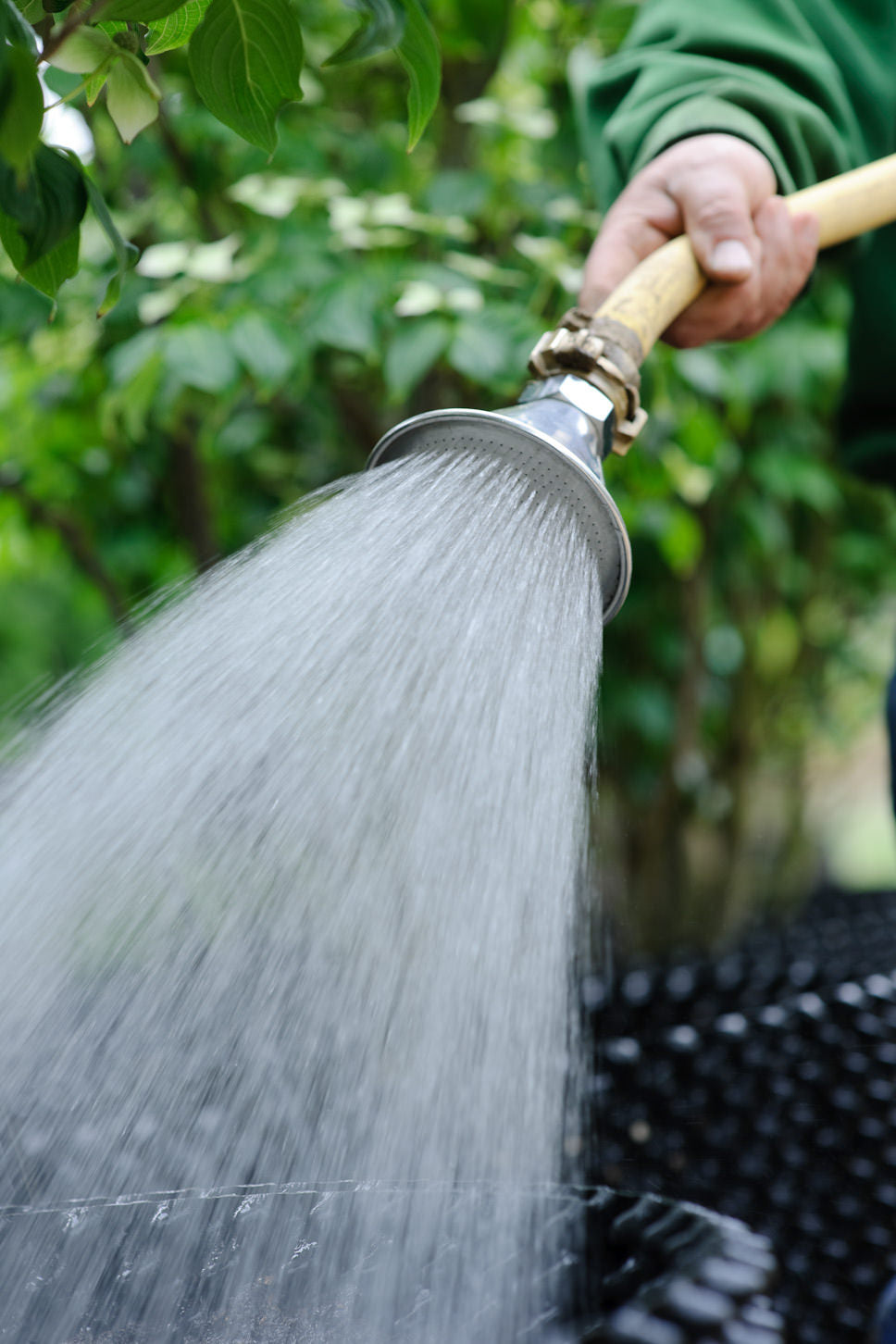Once fully rooted out, your trees will thrive without watering. Until then, they will be relying on you for support. Watering newly planted trees is quite different than watering flowerbeds, so please do take the time to familiarise yourself with our advice below.
If your trees were planted into damp soil in the winter, you may not need to water them at all until spring. Deciduous trees in their leafless dormant phase will have no water requirements until spring; evergreen trees never become fully dormant through the winter so may need a little top up watering if we have a dry winter.
The spring and summer months are the crucial watering season. Your trees will be in their active growth phase so will have much higher demands for water. Begin monitoring the weather and ground moisture levels in March, bearing in mind that sunny exposed areas with light soils will dry out much faster. There is no need to start watering until the ground begins to show signs of drying out (firm underfoot, low air humidity, etc.), but do closely watch your trees for signs of life. They will rapidly start draining moisture from the soil as they enter their active growth phase, so be ready to water on demand. Your first watering of the season could be as late as May or as early as March, depending on site conditions and weather.
As autumn approaches and your deciduous trees start winding down, their water requirement will ease considerably. However, it is still important to monitor soil moisture levels for as long as your trees are in leaf and/or fruit, especially during warm, breezy, ‘indian summer’ weather. Soil moisture levels will need to be monitored for evergreen trees throughout the autumn and winter, although their water uptake is minimal in these seasons.
250-1200L. Trees of this size can usually be planted with relative ease using our specialist handling equipment, and are well worth the increase in planting cost for the impact they provide.
Over 1200L. Planting truly majestic specimens such as these need some careful planning and a little more investment in planting, but provide spectacular instant impact.
The secret to watering newly planted trees is to water them as generously as possible without waterlogging the soil, and then to allow the soil to dry out just enough between soakings to encourage the roots to seek moisture from the surrounding soil. How you achieve this will depend on the watering strategy you’ve put in place. The traditional hosepipe method is most popular and very suited to most residential planting projects. If you have a large number of trees or are away from your property frequently, we recommend you consider having an above ground automatic watering system installed at time of planting. Those with open space plantings distant from a water source may wish to consider using slow release treegator bags which can be topped up quickly a few times per week.
Hosepipe Method
Watering with a hosepipe is very effective if done correctly and with due diligence. We advise the following method:
- Adjust the flowrate of your hosepipe so the water is flowing as fast as possible without running off across the surface of the soil. The aim is absorption.
- Start by watering the surface of the soil around the base of the trunk, then gradually work outwards ensuring you have allowed sufficient time for the water to penetrate deeply into the soil (the aim is to moisten all the soil surrounding the rootball, vertically as well as horizontally). Hint: If your soil is free draining and not prone to waterlogging then laying the hose on the surface and moving it periodically can be an efficient method.
- Continue soaking the soil in an outward radius becoming slightly more generous as you reach the zone just beyond the outer edge of the rootball. The aim is for this area to dry out last, enticing the roots to extend into it as the tree becomes thirsty.
- Continue to soak the soil beyond the rootball edge until you have created a damp circle around the trunk which is approximately 1/3 larger than the actual rootball diameter.
- If the weather is particularly hot and you have had a perforated pipe installed around the rootball (larger stock), finish the watering by turning up the pressure slightly and delivering a few short bursts of water into this pipe. This will deliver water to the deeper root zone. (CAUTION: do not leave the hosepipe running in this pipe and do not use if the water backflows up the pipe or does not drain freely.)
Automatic watering system.
Your system installer set up your system and help you programme a watering regime into your timer. You will need to check the trees every couple of days in the growing season to ensure the soil around the rootball is moist but not waterlogged and the trees are not looking stressed. Increase or decrease the watering regime as required (see ‘how much water’ below). You can read more about our automatic irrigation systems here.
Treegators
Keep your treegator bags topped up with water during hot weather (2-3 times per week is usually sufficient). If the ground starts to become overly saturated, allow the bags to drain completely and do not refill until moisture levels dry to an optimum level (see ’how much water’ below). Treegators are particularly useful for sites not easily accessible by mains water, as they can be quickly filled with a bowser, or for sites where an untended hosepipe would pose a trip hazard.
We are continually asked ‘how much water should I be giving my trees?’. If only there was an easy answer!
Ideally, one hour after watering, the soil around the rootball should feel moist, but should not be wringing with water if squeezed gently in the hand. The amount of water you will need to apply to achieve this will vary depending on the size of tree and your soil type.
Size of tree. It will take more water to saturate the soil surrounding a large rootball than a small one. Remember the objective is to apply enough water to moisten the zone of soil surrounding the rootball both laterally and vertically. For larger specimens, we usually install a perforated watering pipe which wraps around the rootball underground. Applying a few short bursts down this pipe AS WELL as saturating the surface will help to deliver water to the lower soil layers more quickly (note of caution: do not be overly generous when watering into the installed pipe as this will waterlog the rootball).
Soil type. Soils vary widely in their properties, and this impacts how they retain moisture. Rich organic soils act like sponges, light sandy soils like sieves, sticky clay soils like earthenware jugs. You can learn more about how to work out your soil type by visiting this page of the RHS website. (Hint: Be sure to take your soil sample from the deeper soil layers, not the surface).
You will need to water sandy soils more frequently; be cautious not to overwater rich organic soils; and be very careful not to over or underwater clay soils, as clay soils waterlog easily but can be very difficult to rewet once baked dry.
Unfortunately, there is no easy formula for determining how often your trees will need to be watered. Just as our personal water requirements vary dramatically depending on our physical condition, size, environment, and the weather, so too will your trees’.
Understanding your soil type ( http://www.gardenersworld.com/plants/plant-inspiration/find-out-your-soil-type/ ) is key, as is remaining observant of weather conditions. Trees rely on evaporation to drive their water uptake, so their uptake will vary dramatically depending on wind, strength of sun and humidity. Estimating how long it might take for clothes to dry on a washing line is an effective, low tech way to monitor the impact of weather on your trees’ evaporation rate. Bear in mind also that trees with large crowns and heavy foliage will have a far higher water demand in periods of active growth.
It is also vital that you are learn to interpret your trees’ needs. Signs of overwatering stress include yellowing leaves, rapid leaf drop, poor growth and spotting on the leaves. Signs of underwatering stress include wilting, dry crisp leaves and leaf/fruit drop. Underwatering is easier to correct than overwatering if caught quickly, so frequent monitoring is important. Newly planted trees may need to be checked every couple of days in hot weather, and must be watered immediately at the first sign of stress.
With good care and excellent growth in the first growing season, you may not need to water younger trees much if at all in the second, unless we have a prolonged period of drought. Trees with girth sizes in excess of 20cm will probably still need supplemental watering in the second season, but less frequently than the first. In both cases, do remember to keep an eye on your trees for any signs of dryness or stress for the first two growing seasons after planting and if a severe drought in the third season.

Remember always that effective watering requires more observation than perspiration. Overwatering is time consuming and will cause more harm than good. Be diligent, follow the guidelines and contact us without delay if your trees start showing signs of distress.

